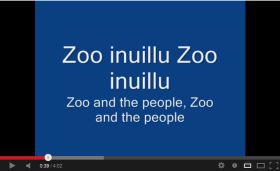The harsh critique of Danish imperialism, featured in lyrics from Greenlandic bands and artists, was problematized early by Siiva Fleischer, the lead singer in the popular band Zikaza, on the band’s first album (1985) and on their legendary release “Miki goes to Nuussuaq” (1988), as several of Fleisher’s lyrics call for overcoming differences of opinion to embark on a new course towards the future (cf. Langgård 1990: 34).
Another turn away from anti-imperialism in the music scene came about in 1989, when the artist Ole Kristiansen released his first album “Isimiit iikkamut” (‘From the eye to the wall’). The album included his hit song “Zoo inuillu” (‘Zoo and the people’) (cf. fig. 10). The lyrics are about the relationship between humans and both nature and the city, and through the lyrics, Kristiansen takes a critical position towards urban spaces by describing them as claustrophobic prisons, whereas nature is seen as a beautiful and vast space in which humans can breathe (cf. Johansen 2001: 181). Even though urbanization in Greenland picked up pace during the Danification period and is often associated with this time, the song is not directly concerned with criticizing Danish imperialism in Greenland, and Ole Kristiansen is noted as a pioneer in the trend in Greenlandic popular music to perform lyrics more concerned with existentialism than anti-imperialism. Meanwhile Ole Kristiansen is celebrated in Greenland for his lyrics and use of metaphor (Focus group interview in Aasiaat, 5 September 2011; cf. Langgård 2011: 162).
Despite the popularity and influence of Zikaza and Ole Kristiansen, a critical stance on Danish influence in Greenland has remained a theme in the lyrics of some Greenlandic popular music, as in Greenlandic society in general. The band Liima Inui (‘The people of Lima’) has taken such a position in some of their songs in the albums “Shaman” (2007) and “Republic” (2009) (Langgård 2013: 87). What is common to both these lyrical trends is however a dedication to forms of nationalism which has remained an important element in popular music lyrics, mainly in numerous songs that praise the beauty of Greenlandic nature, but also in songs about legendary figures from Greenlandic myths. Both Zikaza and Ole Kristiansen utilize these themes in songs about Kaassassuk (cf. Johansen 1991: 85), an orphan boy who is tormented by others from his community but eventually seeks Pissaap Inua (‘The master of the force’) and from this creature, receives superhuman strength that allows him to inflict vengeance on his tormenters. Kaassassuk has often been used as a symbol of Home Rule and Self Government, and a statue of Kaassassuk and Pissaap Inuahas been erected in front of the government complex in Nuuk.
Performing a sense of place in popular music has remained an important feature in this performance of nationalism, but sometimes the connection between the music and a Greenlandic place is very subtle, and achieved through metaphors that take on a particular meaning in a Greenlandic context. An example of this is the track “Puttaaruunnaaq” (‘Floating ice’) from the album “Tunissut” (‘The gift’) (2006). The album is written by Pilu Lynge, but all songs are sung by Kimmernaq Kjeldsen who, like Pilu Lynge, is from Aasiaat. Puttaaruunnaaq is the name of a game children play in some places in Greenland, when enough floes (or floating ice) are floating in the fjords for them to jump between floes. In the song lyrics, this game is used as a metaphor for a protagonist living a dangerous life. Furthermore, the recorded version of the song features both the sound of creaking ice and a reference to frame drum performance.
Even though in the late 1980s trends in composing lyrics in popular music underwent a change in Greenland, Greenlandic culture, nature, myths and history has remained resources for artists looking to perform a sense of place, and this context can therefore be important for gaining particular understandings of lyrics and other musical elements.
Fig 10: ”Zoo Inuillu” (’Zoo and the people’) by Ole Kristiansen (1989).

